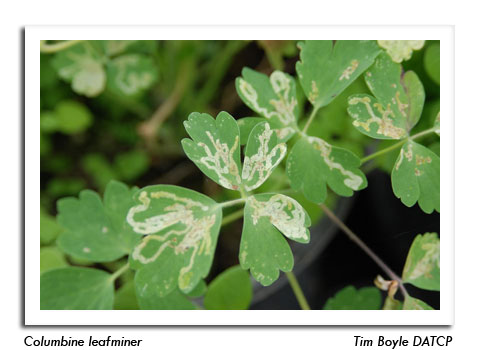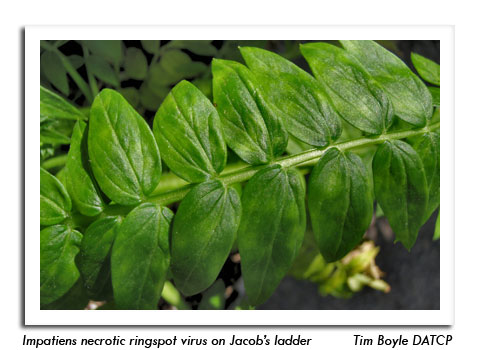
 |
|
|
Nursery & Forest
Volume 56 Number 8 Date 06/16/2011 BROOM RUST - Balsam fir trees in Eau Claire County are beginning to show rust pustules on the lower surfaces of needles. The orange spores produced in the pustules will become windborne and spread infection to chickweed hosts in Christmas tree fields. Balsam firs in fields heavily infested with chickweed may develop a dozen or more broom growths, greatly reducing quality and marketability. Removing the alternate host and pruning out and destroying the brooms is suggested. ARABIS MOSAIC VIRUS - Hosta suppliers who test only for hosta virus X (HVX) should be aware of the six other known virus diseases of hostas, including Arabis mosaic virus (ArMV), impatiens necrotic spot virus (INSV), tobacco rattle virus (TRV), tobacco ringspot virus (ToRSV), tomato ringspot virus (TomRSV) and tomato spotted wilt virus (TSWV). Of these viruses, HVX is the most common and ArMV is perhaps the rarest. Arabis mosaic virus causes leaf blanching, spotting, and occasionally stunting or a mosaic pattern. Some infected plants may remain asymptomatic. This virus is transmitted by vegetative propagation, nematodes and pollen. Infected plants must be eliminated to prevent spread. MAPLE EYESPOT GALL - The maple variety 'Burgundy Belle' was lightly infested with this gall midge (Cecidomyia ocellaris) at nurseries in Eau Claire and St. Croix counties. The leaf gall larva causes a circular spot on maple leaves which is often mistaken for a fungal leafspot. This is not an insect that requires control. --Konnie Jerabek, DATCP Nursery Inspector COLUMBINE LEAFMINER - Leaf mines caused by the larval stages of this insect were noted this week on columbine in a Sauk County nursery. The serpentine mines initially appear whitish in color and eventually turn tan or brown later in the season. Removing and destroying infested leaves will reduce this aesthetic problem. SEPTORIA LEAF SPOT - Spirea shrubs in Sauk and Columbia counties were showing symptoms of this common fungal disease, characterized by small, dark lesions that first appear on the lower leaves and stems and later enlarge and spread to the upper leaves. Control consists of spacing plants to increase airflow. --Ellen Hermanson, DATCP Nursery Inspector IMPATIENS NECROTIC RINGSPOT VIRUS - This virus disease was confirmed on a Jacob's ladder sample collected from a West Bend garden center. INRV is spread primarily by the western flower thrips and propagation of infected plants or cuttings. Symptoms vary by host and may include stunting, brown or yellow circular spots on leaves, ring spots, black or brown stem discoloration, browning of leaf veins, yellow line patterns in leaf tissue, or as in this case, mosaic patterns. Impatiens Necrotic Ringspot Virus can infect plants such as New Guinea impatiens, exacum and gloxinia, rendering them unsalable. More than 300 plant species from 50 plant families are susceptible, most notably: African violet, ageratum, amaranthus, anemone, aster, begonia, calendula, calla lily, chrysanthemum, coleus, cosmos, cyclamen, dahlia, fuschia, marigold, petunia, snapdragon, verbena and zinnia. Control of thrips populations in greenhouse settings is critical to reducing INRV spread. Petunias can serve as indicator plants. For example, the cultivars 'Calypso', 'Super Blue Magic', and 'Summer Madness' develop brown ringspots around thrips feeding scars if the virus has been effectively transmitted. Carrying over plant material from season to season increases the risk of INRV and should be avoided by nurseries and greenhouses with virus problems. Plants infected with this virus must be promptly destroyed. --Tim Boyle, DATCP Nursery Inspector GYPSY MOTH - The last of this year's Btk treatment was completed in Bayfield County on June 13. More than 58,000 acres were treated by the DNR Suppression Program and the DATCP Slow the Spread Program. Mating disruption treatments may start as early as next week in southern Wisconsin. --Nkauj Vang, DATCP Gypsy Moth Program EMERALD ASH BORER - Parasites of this ash tree-killing beetle were released on June 8 near Newburg in Ozaukee County. This is the first year of the interagency effort to introduce natural enemies for eventual control of emerald ash borer. Two species of stingless wasps that parasitize the larval stages were released and a third species that attacks the eggs will be introduced later this summer. ELM SPANWORM - DNR specialists believe there is a potential for moderate defoliation by this caterpillar in the Greenfield, Freedom, Merrimac and Sumpter townships of Sauk County. The twig-like larvae are either slate black or light green; the darker form is more abundant at high population densities. Both color variations were noted in the Parfrey's Glen area. --Krista Hamilton, DATCP Entomologist 





|
|
|